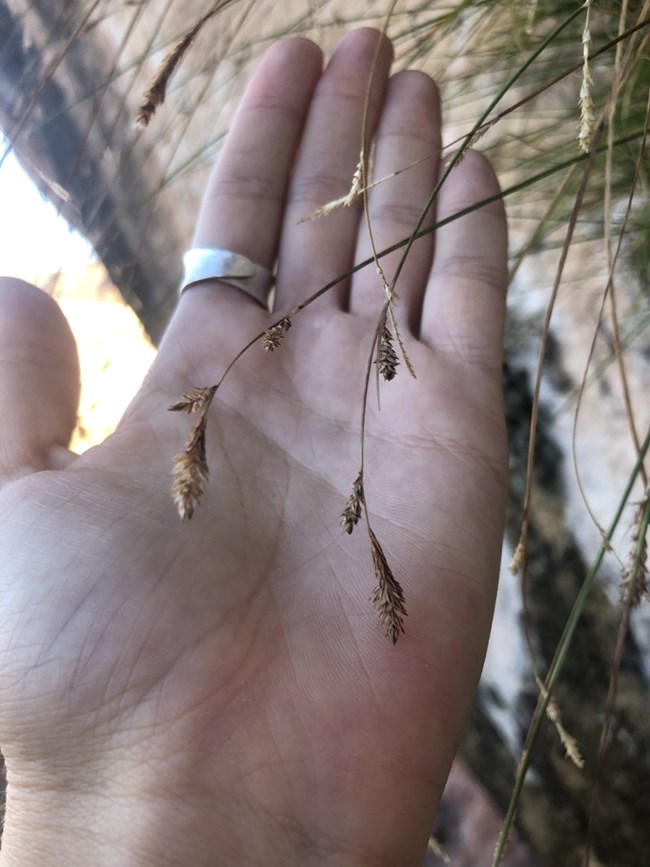Last updated: June 9, 2025
Article
Where Water Seeps, Life Clings: Protecting Navajo Sedge in Natural Bridges
By Christina Martin, I&M Research Scientist and Communication Specialist
May 2025
Tucked into the red rock cliffs of Natural Bridges National Monument (NM) is a rare plant hanging on in a challenging environment. The Navajo sedge (Carex specuicola) grows only in places where water trickles out of sandstone—cool, shady ledges called hanging gardens. These hidden spots are home to plants found nowhere else.
But even in a national monument, this rare sedge faces serious threats.

NPS
Why the Park Needed to Learn More
The Navajo sedge is listed as a federally threatened species. That means parks like Natural Bridges NM are required to track how it’s doing and make sure park activities aren’t causing harm. Some of the biggest threats to the plant outside the monument are livestock grazing and the drying up of seeps. Luckily for the sedge, livestock grazing isn’t allowed inside the park—but drought and invasive species still pose risks.
In summer 2022, Natural Bridges NM staff teamed up with the National Park Service Inventory and Monitoring Program to do a deep dive into the sedge’s status. They needed to find out where it still grows and how the populations are changing.

NPS
Search for the Sedge
Over the course of a few months, the team searched high and low. They hiked to 90 seeps across 716 acres of canyon terrain. Some seeps were easy to reach. Others required careful climbing along ledges or navigating steep rock faces. Because seeps and hanging gardens can be slippery and delicate, safety and plant protection came first. If a spot wasn’t safe to reach without damaging the habitat, it was noted and skipped.
Navajo sedge looks a lot like two other sedge species that grow in the same habitat, Ross's sedge (Carex rossii) and golden sedge (Carex aurea), so researchers had to pay close attention to fine details to tell them apart. Timing also mattered for identification. The sedge flowers in June, and by mid-July, the plants had started drying out and were harder to identify. When researchers suspected they had found Navajo sedge, they collected small leaf samples to support a genetic study led by the U.S. Geological Survey.

NPS
What They Found and What It Means
The project documented four populations of Navajo sedge. The two previously recorded populations were rediscovered, and, encouragingly, two unrecorded populations were found. While the total number remains small, it’s a positive sign that none appear to have been lost.
Still, finding these populations is just the beginning. This inventory helps the park plan how to protect the plant going forward. That could mean keeping fences secure to block livestock, working with nearby landowners to protect the water sources that feed the seeps, or preventing the spread of invasive plants that might outcompete the sedge. Data from this study is also being used to improve computer models that predict where Navajo sedge might grow across southeastern Utah, which will help guide future conservation efforts.
This little plant isn’t famous. It doesn’t bloom big or stand tall. But it’s a sign of water in a dry place—and of a park working hard to protect what helps make its canyons special.
Tags
- natural bridges national monument
- inventory
- inventories
- species inventory
- inventory and assessment
- inventory and monitoring division
- natural resource stewardship and science
- utah
- biodiversity
- native plants
- sedge
- vegetation
- resource management
- natural resource management
- collaborative conservation
- northern colorado plateau network
- ncpn
